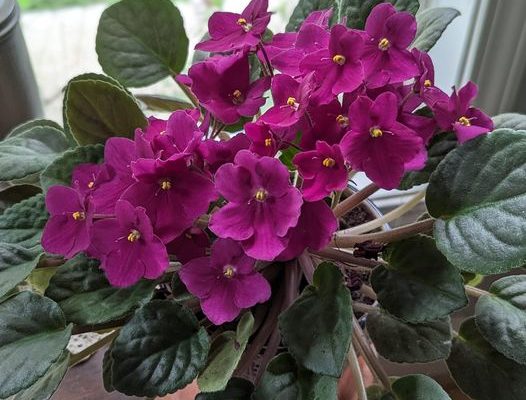Under this non-changing light intensity, these low-light plants grow gorgeous foliage and bloom profusely.
Space them so the pot rim is about 14 inches from the light tube, and leave the lights on for 12 to 14 hours each day.
The average household temperature, 72° to 75° degrees Fahrenheit during the day with the usual five to 10° degree drop at night, seems to suit them.
All episcias need more watering than African violets and grow best under high humidity conditions. Episcia grows well with bottom watering.
If the air circulation in your home is too dry (under 40 percent humidity) episcias and all of your houseplants will benefit when set on a pebble tray of water kept just below the pot line.
Episcias are beautiful no matter whether they are in bloom or not
To keep the foliage in top showoff condition, give them water as often as needed to keep them free of dust. Use room-temperature water and keep them out of direct sunlight until the leaves are dry.
Give houseplant food to Episcias twice a month with any good water-soluble liquid fertilizer, remembering, of course, to fertilize only on well-moistened soil. This safeguards tiny roots from fertilizer burn.
Keep episcias pest-free by giving them a thorough inspection for pests.
How To Propagate Episcia
If older episcia plants have shed leaves and look straggly, trim runners off the mother plant and repot the old plant. You can start new plants From the pieces.
Propagate episcias from leaves, runners, or seeds. Root leaves and runners in water, vermiculite, sphagnum moss, or sand. Cover them with a small glass or clear plastic cup to increase humidity, speeding up root formation.
You can get infinite foliage and flower variety by growing episcias from seed.
Sprinkle the seed on moistened sphagnum moss or vermiculite. They germinate in ten days to three weeks and as soon as the little plants have four good leaves prick them out and plant them in a pot or flat.
Given good growing conditions, the potted plants will flower from seed in eight to 12 months.
Pin Episcias can also be propagated from leaf cuttings taken in the same manner as when starting gloxinias and African violets. Episcias are, however, rather slow from leaves, and stolons are produced in such abundance that it is rarely advantageous to use a leaf cutting.
Episcias can easily be obtained as mail-order houseplants at some local greenhouses and occasionally garden centers.
If you want to turn some of your episcia plants into conversation pieces, try some of these ideas.
1. Use any of the episcias as trailers in the foreground of container gardens using taller upright plants in the background.
2. Grow two or more kinds of Episcias in a large pot with the background plants trained up a moss-filled “totem” pole or a porous piece of a tree stump or root. As a starter, fasten the episcia runners to the pole with green wire Twist-ems. Keep the support moist and the episcia roots will grow into it.
3. Plant episcias in moss-filled hang baskets and hang them in your window garden or greenhouse or summer them on a shaded covered terrace .
4. Try a plant in a rose bowl or small aquarium. Here, with the added high humidity they receive, they grow as lush as they would in their homeland.
5. Grow some episcias in an attractive container filled with water. Change the water once a week, give them bright indirect light, and add a wee pinch of plant food, and you’ll enjoy them on an occasional table or the mantel. You may even find yourself using them as a hurry-up centerpiece.
Episcia Questions and Answers
Question: Please tell me something about the Episcia cuperata red violets (a species of episcia), how to water them, how to start slips, and what conditions they need.
Answer: The word episcia means shade-loving. The plant is closely related to the African violet and gloxinia and responds to the same culture.
The episcia needs no rest period and prefers a warm, humid atmosphere. It produces stolons like a strawberry. These may be inserted into a neighboring pot of moist soil while they are still attached to the parent plant.
After a few weeks, the stolon will have formed its own roots and may then be clipped from the parent. Plant episcias in porous, light, rich soil and water them regularly.
Question: Why do the flower buds of my flame violets dry up and fall off?
Answer: Episcia reptans (formerly called Episcia coccinea and fulgida), sometimes “flame violet,” likes to grow in a warm, humid place. Indoors we have flowered episcias in windows facing all directions with a humidity range of 40 to 60 percent. Temperatures below 60° degrees Fahrenheit are uncomfortable for episcias.
Try to provide more humidity by grouping several plants together, preferably on a tray of moist sand or pebbles. The dry heat of many rooms is the hardest indoor gardening problem to solve.
Most dwellings have two windows that are likely to be more humid than others: the window above the kitchen sink and the one above the bathtub.




